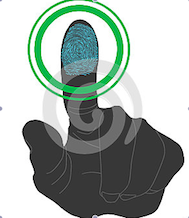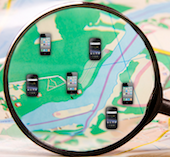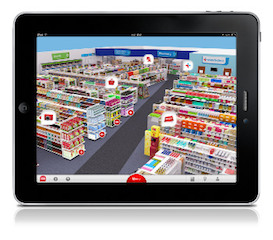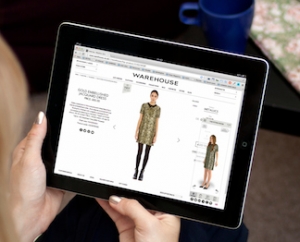We've got 5 key ecommerce app trends to watch for today and the future. Many mobile app development companies start publishing their industry predictions and expectations. Intersog isn't an exception and here's our List of Top 5 eCommerce app trends to watch that are happening and picking up momentum!
QR Code Shopping Apps
 QR codes haven't become as popular and mainstream in Europe or North America as they're in Asia (especially South Korea and Japan). New technologies may give a second life to QR codes in the Western world. Mobile retail is one of the areas to let QR codes gain momentum. Retailers may put their codes anywhere they want allowing prospective buyers to scan them. Sending buyers to the relevant landing page to place an order right away.
QR codes haven't become as popular and mainstream in Europe or North America as they're in Asia (especially South Korea and Japan). New technologies may give a second life to QR codes in the Western world. Mobile retail is one of the areas to let QR codes gain momentum. Retailers may put their codes anywhere they want allowing prospective buyers to scan them. Sending buyers to the relevant landing page to place an order right away.
In South Korea, for instance, the most busy places already have virtual shop-windows. Metro stations, bus stops and trade centers are covered with paper copies of the actual department store product lines to stimulate and speed up purchasing. QR code shopping enables direct purchasing from magazines, TV screens or concrete walls via QR code scanning. See how Shopify recommends using QR codes to enhance the shopper experience.
Read more about ios app development in our solutions.
Biometric Shopping Apps
 Whereas QR codes allow for immediate purchasing decisions and product choice, biometric sensor technologies allow for immediate payments. Biometric fingerprint IDs will provide a great solution for one of the biggest challenges of today's online retailers - secure retail point of sale systems. Today may be the start of a one-tap authentication era. No wonder Apple has equipped the latest iPhone with a fingerprint scanner enabling fast and secure one-tap password-free purchasing through iTunes, the App Store and iBooks Store. So, if you're thinking over what type of an app should be built to disrupt the marketplace - consider creating a touch ID one. Even if biometric shopping fails to go mainstream, it will for sure in the years to come after.
Whereas QR codes allow for immediate purchasing decisions and product choice, biometric sensor technologies allow for immediate payments. Biometric fingerprint IDs will provide a great solution for one of the biggest challenges of today's online retailers - secure retail point of sale systems. Today may be the start of a one-tap authentication era. No wonder Apple has equipped the latest iPhone with a fingerprint scanner enabling fast and secure one-tap password-free purchasing through iTunes, the App Store and iBooks Store. So, if you're thinking over what type of an app should be built to disrupt the marketplace - consider creating a touch ID one. Even if biometric shopping fails to go mainstream, it will for sure in the years to come after.
GPS-based Delivery
 Selected via QR code scan and paid with a finger touch, goods in the near future will be delivered based on our GPS location tracking. So, as a retailer, you should be ready to deliver your goods based on customer's GPS location. This will drive a demand for GPS tracking apps to enable goods delivery to anywhere. Regardless if it's an office or a chaise lounge on the beach.
Selected via QR code scan and paid with a finger touch, goods in the near future will be delivered based on our GPS location tracking. So, as a retailer, you should be ready to deliver your goods based on customer's GPS location. This will drive a demand for GPS tracking apps to enable goods delivery to anywhere. Regardless if it's an office or a chaise lounge on the beach.
Virtual 3D Shops
 In order to bring an offline shopping atmosphere to the online and mobile spaces, retailers will be investing more into mobile app development of 3D shopping experiences. As such, 3D eCommerce apps will be in high demand. Allowing us to have shopping experiences as close to offline shopping as possible. We'll "walk through" the aisles, talk to virtual assistants while choosing products, and pay at the virtual cash desk. Some of the world's leading merchandize retailers including Tesco are planning to create such 3D shopping apps next year. America's biggest pharmaceutical company CVS has already launched its iOS-based 3D drug store project this year that imitates actual products range in each separate store location - just choose its physical address from the drop-down and voilà!
In order to bring an offline shopping atmosphere to the online and mobile spaces, retailers will be investing more into mobile app development of 3D shopping experiences. As such, 3D eCommerce apps will be in high demand. Allowing us to have shopping experiences as close to offline shopping as possible. We'll "walk through" the aisles, talk to virtual assistants while choosing products, and pay at the virtual cash desk. Some of the world's leading merchandize retailers including Tesco are planning to create such 3D shopping apps next year. America's biggest pharmaceutical company CVS has already launched its iOS-based 3D drug store project this year that imitates actual products range in each separate store location - just choose its physical address from the drop-down and voilà!
Read more about android app development in our solutions.
Virtual Fitting Rooms
 One of the key arguments online shopping opponents use is that we can't physically touch and feel clothes we buy online. Thus, are at risk of buying a pig in a poke. To minimize such a risk more retailers will develop virtual fitting rooms based on the following technology. A robotic mannequin that simulates any body proportions to the nearest inch is photographed a thousand times. Each time with a 1-inch deviation from the previous parameter. Then these pictures are uploaded to the database. Once we've inserted our proportions, the database filters out pictures that best match our body parameters. Then, we can easily "try on" clothes and see whether it fits us well or not.
One of the key arguments online shopping opponents use is that we can't physically touch and feel clothes we buy online. Thus, are at risk of buying a pig in a poke. To minimize such a risk more retailers will develop virtual fitting rooms based on the following technology. A robotic mannequin that simulates any body proportions to the nearest inch is photographed a thousand times. Each time with a 1-inch deviation from the previous parameter. Then these pictures are uploaded to the database. Once we've inserted our proportions, the database filters out pictures that best match our body parameters. Then, we can easily "try on" clothes and see whether it fits us well or not.
Alternatively, such virtual dressing room apps can be based on the computer algorithm that models our exact body shape based on pictures and body parameter inputs we provide. An example - London based startup Metail uses 3D visualization technology. It enables a shopper to upload a photo and basic measurements to create an own virtual representation and try on garments online).
As we see, in the near future the ecommerce app trends to watch will be more interactive and targeted. Today, we get product recommendations based on our social media interactions and online behavior. Tomorrow, goods will be marketed to us based on our appearance, brands we wear and things we do offline. Sounds incredible, doesn't it?






